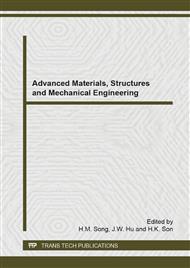[1]
Y. Hsiao, A mathematic model of thermoelectric module with applications on waste heat recovery from automobile engine, Energy, Vol. 35 (2010), 1447–1454.
DOI: 10.1016/j.energy.2009.11.030
Google Scholar
[2]
W.H. Lai et al., Experimental simulation on the integration of solid oxide fuel cell and micro-turbine generation system, Power Sources, Vol. 171 (2007), 130–139.
DOI: 10.1016/j.jpowsour.2006.11.017
Google Scholar
[3]
Basel I. Ismail and Wael H. Ahmed, Thermoelectric Power Generation Using Waste-Heat Energy as an Alternative Green Technology, Recent pantents on electrical engineering, . Vol. 2 (2009), 27–39.
DOI: 10.2174/1874476110902010027
Google Scholar
[4]
Gou X, Xiao H. and Yang S. Modeling, Experimental study and optimization on low temperature waste heat thermoelectric generator system, Apply Energy, Vol. 87 (2010), 3131–3136.
DOI: 10.1016/j.apenergy.2010.02.013
Google Scholar
[5]
Wee D., Analysis of thermoelectric energy conversion efficiency with linear and nonlinear temperature dependence in material properties, Energy Conversion and Management, Vol. 52 (2011), 3383–3390.
DOI: 10.1016/j.enconman.2011.07.004
Google Scholar
[6]
Bélanger S. and Gosselin L. Thermoelectric generator sandwiched in a crossflow heat exchanger with optimal connectivity between modules,. Energy Conversion and Management, Vol. 52 (2012), 2911–2918.
DOI: 10.1016/j.enconman.2011.02.019
Google Scholar
[7]
Crane DT. and Jackson GS. Optimization of cross flow heat exchangers for thermoelectric waste heat recovery, Energy Conversion and Management, Vol. 45 (2004), 1565–1582.
DOI: 10.1016/j.enconman.2003.09.003
Google Scholar
[8]
Rodriguez A., Vian JG., Astrain D. and Martinez A., Study of thermoelectric systems applied to electric power generation, Energy Conversion and Management, Vol. 50 (2009), 1236–1243.
DOI: 10.1016/j.enconman.2009.01.036
Google Scholar
[9]
Whalena SA. and Dykhuizenb RC., Thermoelectric energy harvesting from diurnal heat flow in the upper soil layer, Energy Conversion and Management, Vol. 50 (2012), 397–402.
DOI: 10.1016/j.enconman.2012.06.015
Google Scholar
[10]
Karabetoglu S., Sisman A., Faith Ozturk Z. and Sahin T. Characterization of a Thermoelectric generator at low temperatures, Energy Conversion and Management, Vol. 62 (2012), 47–50.
DOI: 10.1016/j.enconman.2012.04.005
Google Scholar
[11]
D. Champier, J.P. Bedecarrats , M. Rivaletto and F. Strub, Thermoelectric power generation from biomass cook stoves, Energy, Vol. 35 (2010), 935–942.
DOI: 10.1016/j.energy.2009.07.015
Google Scholar
[12]
Maneewan S., Khedari J., Zeghmati B., Hirunlabh J. and Eakburanawat J. Investigation on generated power of thermoelectric roof solar collector, Renewable Energy, Vol. 29 (2004), 743–752.
DOI: 10.1016/j.renene.2003.10.005
Google Scholar
[13]
Vatcharasathien N., Hirunlabh J., Khedari J., and Daguenet M., Design and Analysis of Solar Thermoelectric Power Generation System, International Journal of Sustainable Energy, Volume 24 (2005), 115–127.
DOI: 10.1080/14786450500291966
Google Scholar
[14]
Dan D., Yixin Z., Jing L., Liquid metal based thermoelectric generation system for waste heat recovery, Renewable Energy, 36 (2011), 3530–3536.
DOI: 10.1016/j.renene.2011.06.012
Google Scholar
[15]
Stevens JW., Optimal design of small DT thermoelectric generation systems, Energy Conversion Management, Volume 42 (2001), 709–20.
DOI: 10.1016/s0196-8904(00)00099-6
Google Scholar
[16]
Yu C., Chau KT., Thermoelectric automotive waste heat energy recovery using maximum power point tracking, Energy Conversion Management, Volume 50 (2009), 1506–1512.
DOI: 10.1016/j.enconman.2009.02.015
Google Scholar
[17]
Miller EW., Hendricks TJ. and Peterson RB., Modeling energy recovery using thermoelectric conversion integrated with an organic rankine bottoming cycle, Journal of Electronic Materials, Volume 38 (2009), 1206–1213.
DOI: 10.1007/s11664-009-0743-1
Google Scholar
[18]
Kristiansen NR., Snyder GJ., Nielsen HK. and Rosendahl L., Waste heat recovery from a marine waste incinerator using a thermoelectric generator, Journal of Electronic Materials, Volume 41 (2012), 1024–1029.
DOI: 10.1007/s11664-012-2009-6
Google Scholar
[19]
Hendricks TJ., Karri NK., Hogan TP., Cauchy CJ. and New perspectives in thermoelectric energy recovery system design optimization, Journal of Electronic Materials, Volume 42 (2013), 1725–1736.
DOI: 10.1007/s11664-012-2406-x
Google Scholar
[20]
Lesage FJ. and Pagé-Potvin N., Experimental analysis of peak power output of a thermoelectric liquid-to-liquid generator under an increasing electrical load resistance, Energy Conversion Management, Vol. 66 (2013), 98–105.
DOI: 10.1016/j.enconman.2012.10.001
Google Scholar
[21]
Frédéric J. Lesage, Éric V. Sempels and Nathaniel Lalande-Bertrand, A study on heat transfer enhancement using flow channel inserts for thermoelectric power generation, Energy Conversion and Management, Vol. 75 (2013), 532–541.
DOI: 10.1016/j.enconman.2013.07.002
Google Scholar
[22]
Yodovard, P. et al., The potential of waste heat thermoelectric power generation from diesel cycle and gas turbine cogeneration plants, Energy sources, Vol. 23 (2001), 213–224.
DOI: 10.1080/00908310151133889
Google Scholar
[23]
Incropera F.P. and De WITT, D.P., Fundamentals of heat and mass transfer, Jonh Wiley & Son, 1990, 449-454.
Google Scholar


